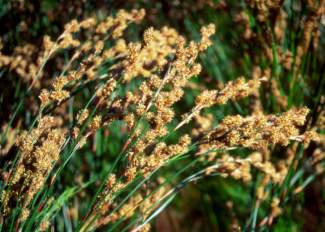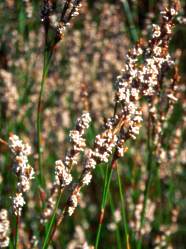Restio multiflorus
Restio multiflorus Spreng.
Family: Restionaceae
Common names: many-flowered restio
Introduction
This is a very attractive, dense, upright, tufted plant that can be used as an accent plant or to provide a grass-like accent in a mixed border or fynbos garden. The sparsely branched flowering stems, rising like a fountain out of a mass of finely branched, bright green, juvenile stems, have dark brown bracts for most of the year.

Description
Description
Restio multiflorus is a reed-like plant, which grows to a height of 1 m in its natural environment, but grows to a height of about 1.5 m if planted in a reasonably fertile soil with the normal amount of water given in a garden. The plants have strong, upright stems and grow in a more or less tufted form. Like many other Restionaceae, the young plants produce finely branched juvenile stems which increase the photosynthesis process and enable the plants to grow faster. R. multiflorus plants have a large amount of these juvenile stems, which are bright green in colour.
When the flowering stems start to grow in the second year they seem to rise like a fountain from this low base of fluffy stems, which produces a striking and very attractive plant. When mature after three years, the plants can reach a diameter of about 1 m at ground level. Plants of both sexes are strong growing and can easily reach an age of about seven years. The main growth period is at the end of the Cape winter (August to November).

Distribution and habitat
Distribution description
Restio multiflorus has a wide distribution in the Cape Floristic Region of the Western Cape and occurs on the lower slopes of mountains from Piketberg in the north to the Bredasberg Plains in the south. The plants are often difficult to recognize as they can grow entangled in other fynbos vegetation, looking quite different to the plants in cultivation in a garden. The plants prefer to grow in cool, well-drained places and can be found on bedrock Table Mountain Sandstone as well as granite, shale or silcrete.
Derivation of name and historical aspects
History
The family name of Restionaceae refers to the Latin restis, which means cord or rope and alludes to the use of the plants in southern Africa. More than 400 species in about 40 genera of the Restionaceae family occur in the winter rainfall regions of South Africa and Australia, with outliers in Africa, Madagascar, Indo-China and Chile. The species name of multiflorus is derived from multus = many and flos = flower and refers to the many spikelets, each with their own lot of flowers, giving a many-flowered appearance.
Ecology
Ecology
Like the other reed species, the male and female flowers are on different plants and both are small. The plants flower during March - April in the Southern Hemisphere and produce seed during November or December. The male flowers are greenish yellow, but the female flowers are very pretty, small but pure white and very frilly. The flowering season is very short, only about two weeks and the decorative dark brown bracts around the male and female inflorescences provide a longer period of attraction, from about two months before the flowering starts, to just after the seed ripens.
The plants are wind pollinated. The wind distributes the pollen from the free-hanging anthers of the male flowers to the female inflorescence where the large bracts catch the pollen from the air and funnel it towards the female flowers. Sometimes bees are present, but always around the male plants, where they collect the pollen. The seeds ripen in small capsules, three seeds to a capsule. When the seeds are ripe, the capsule opens up and dispels the seeds, which makes daily inspection during the ripening period absolutely necessary, if the seeds are to be collected for propagation. The seeds are quite small, shiny, dark brown nuts and are produced in large quantities per plant.

Uses
Use
The economic use of plants of this family has been limited, as the plants contain a large amount of tannin and so are grazed only as a last resort by cattle and sheep. The species that have simple, unbranched stems are sometimes used for thatching, while the species with branched stems are used as brooms or besems. The plants have been introduced to horticulture and are available from nurseries. Restio multiflorus is quite popular as a garden plant, or planted in larger groups in landscaped gardens around large buildings or along roads.

Growing Restio multiflorus
Grow
This species is best used as an accent plant or grown in a large pot and can also be used in a fairly large garden as a plant in a large border, planted behind a group of smaller plants. The plants fit in with fynbos plants, other indigenous South African plants as well as any other plants in a garden. They can be used as if they were small shrubs and would provide the touch of grass-like plants now so fashionable in landscaping. Another use would be as a group of plants in a large landscaping project, the plants are especially suited to planting on a slope.
The plants are best grown from seed, which has a good germination rate and germinates even better if treated with smoke or 'Instant Smoke Plus' seed primer.
This species must be grown in full sun, prefers a well-drained soil and plenty of air movement. The plants adapt to a large variety of soil types. The best time for planting restios is at the beginning of the rainy season, as the plants need regular watering during the first six weeks to two months after planting. After this initial period the plants can survive with a little additional watering, but grow better with a normal garden watering regime. They may be fed with standard organic fertilizers based on seaweed, or by sprinkling the surrounding soil with a small amount of ammonium sulfate during the growing season. Restios will respond to regular watering by showing more robust growth, but they are essentially plants adapted to a long, dry season.
In the garden, plants should be grown with a regular amount of irrigation and are suited to cultivation in gardens in the Southern Hemisphere. As with other reed species, the roots are sensitive to a combination of frost and wet soil and in the Northern Hemisphere should be grown in pots.
This is a fast-growing species that will be nearly 1 m high one year after sowing and will have formed a handsome plant three years after sowing. The plants produce a new growth flush in the centre of the plant every year. The individual stems start to deteriorate during the third year but by that time already two new flushes of growth will have appeared for the yearly renewal of the plant. This governs the maintenance of the plant, which only needs a regular removal of the brown, dead stems on the outside part of the plant.
References
- ANDREWS, S. & MCCLINTOCK, D. 1982. Notes on Restio subverticillatus. The Plantsman 37: 230-233.
- BROWN, N., JAMIESON, H. & BOTHA, P. 1998. Grow restios. Kirstenbosch Gardening Series. National Botanical Institute, Cape Town.
- DORRAT-HAAKSMA, E.& LINDER, H. P. 2000. Restios of the Fynbos. The Botanical Society of South Africa, Cape Town.
- LINDER, H.P. 1985. Conspectus of the African species of Restionaceae. Bothalia 15.
- LINDER, H.P. 1991. A review of the southern African Restionaceae. Contributions from the Bolus Herbarium No. 13.
Credits
Hanneke Jamieson
Kirstenbosch National Botanical Garden
May 2003
Plant Attributes:
Plant Type: Restio
SA Distribution: Western Cape
Soil type: Sandy, Clay, Loam
Flowering season: Winter
PH: Acid, Neutral
Flower colour: Brown
Aspect: Full Sun
Gardening skill: Average
Special Features:
Horticultural zones







Rate this article
Article well written and informative
Rate this plant
Is this an interesting plant?
Login to add your Comment
Back to topNot registered yet? Click here to register.